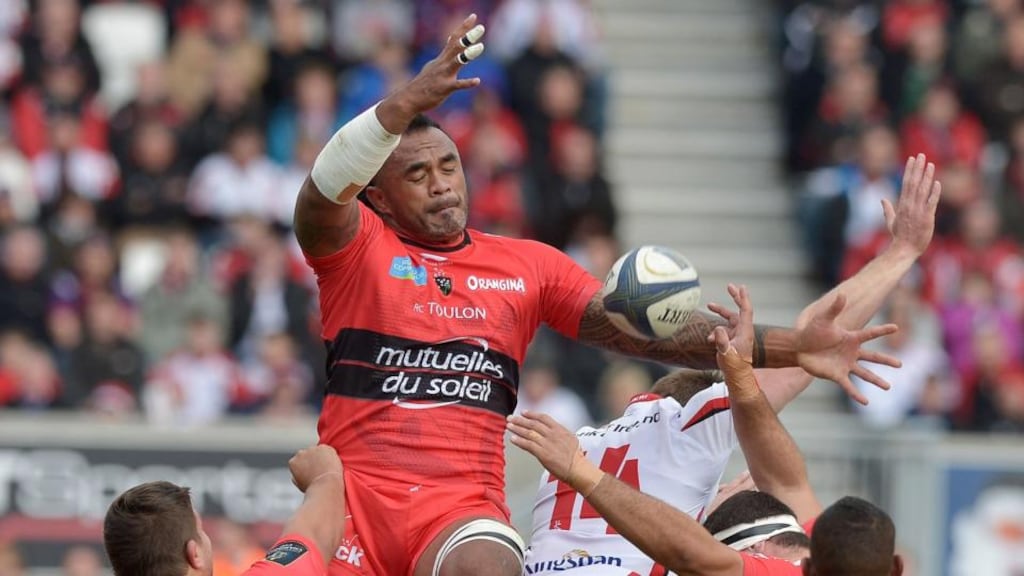I notice Law 10.4 (c) is back in the picture where a player must not kick an opponent. It's not the first time a secondrow got his timing wrong but what Toulon lock, Romain Taofifenua, did to Ulster's Stuart Olding needs deeper analysis.
The laws centring on the breakdown are often misinterpreted by a packed stadium as fans, in many cases, are not up to speed with the exact letter of the law. Cast your mind back to your last sighting of Richie McCaw, the greatest proponent of the breakdown, and ask yourself how often have you screamed at his actions before becoming perplexed at the referee’s reaction? Why the disjoint? A lack of knowledge?
At the top level, the number of scrums in a game is generally in the low teens, a reflection of the positive skill set of professional players. But a huge tract of time is spent debating 12 scrums a match, the laws and their interpretations. There are typically 50 per cent more lineouts per match (18), a reflection of teams’ tactical management of possession and field position with still more debate. But, there are about 1,300 per cent more breakdowns per match (150+) yet the 2014 laws remain a mystery to many watching.
What indeed is a ruck? When exactly is it formed? And when formed, what actions are the players allowed by the laws?
More power
For instance, we often see a player miraculously popping up from the middle of a ruck, with the ball and scampering off scot-free as the defensive pillars are left in his wake.
Ulster's Nick Williams has made many yards off this tactic and more power to him and his team. But the only person to legally place his hands on the ball is the acting scrumhalf from outside the ruck. When the ball is rooted in debris, the referee will generally afford the scrumhalf an opportunity to place his hands on the ball whilst extracting, without the opposition fringe defence coming forward. A gentleman's agreement if you will. The flying boot is a major exception to this agreement.
When Olding carried the ball in open field against Toulon he was tackled by Juan Smith. As both hit the deck Romain Taofifenua arrived to poach the ball but so too did Ulster's openside Chris Henry who engaged Taofifenua.
Now we have two players in contact over the tackle; a ruck is now formed. Taofifenua has a number of options – drive Henry back over the ball leaving the ball on Toulon’s side, tin can open Henry sideways or, finally, kick the ball. Had Taofifenua got on the ball prior to Henry’s arrival and subsequent formation of the ruck, Taofifenua could have remained legally in that position for as long as he liked, even after the ruck formed. This often exercises players and supporters no end and this particular action requires enormous refereeing common sense and management of players.
It’s not an exact science, it occurs quickly and requires an immediate decision which can be wrong, hence the referee’s ability to manage the player’s frustrations through those little off-piste conversations; not all referees have this skill.
The flying boot brings an element of controlled savagery, which is hardly within the spirit of the game, but it crucially affords a contest for the ball, which is core to our game. At present, players are prevented from handling the ball in a ruck (declared or otherwise) although the tackling player has certain rights – where he’s allowed to stand and exit the evolving ruck etc. But! Kicking the ball is permitted at all stages which is why we continue to see flying boots. Often these flying boots are the last acts of a desperate forward who is aware of the general whereabouts of the ball and is intent in making the passage of the ball as sloppy as possible, forcing a scrumhalf to knock on or worse.
Nimble athlete
That is the intention. For a moment forget Taofifenua’s intention and focus entirely on the recklessness of the action, often blind and often from a man towering over six feet and 100-plus kilos and crucially from a far less nimble athlete than a back tuned to kicking (rugby balls).
There's no way the 123kg Taofifenua intended to kick Olding, but this I'm afraid is entirely immaterial as the impact this style of rucking will have throughout the game is widespread where kids idolise their heroes and immediately mimic their every act. Look at the number of underage swan dives at try -time copying Saracens and England winger Chris Ashton.
Swan dives are to be enjoyed as the manifestation of positive team effort in creating the most cherished of outcomes: a try. Taofifenua’s actions are not to be celebrated.
That said, referee Wayne Barnes was perfectly placed to observe the ruck, more so than Taofifenua who was blind to the ball. I don't know what Barnes concluded but he didn't review it. Did he see the incident and choose to ignore the kick as innocent?
If he missed it, which is reasonable with so much happening, why didn’t he refer to the TMO foul play protocols and investigate why Olding had to exit?
There is a duty of care throughout our game to ensure safety is paramount, especially to the head. Hence this is not a low-end or even a mid-range act; this is top-end stupidity and merits a long and well-advertised ban to ensure that the next secondrow (underage or otherwise) needs to know where the exact location of his feet are relevant to the many unprotected heads in the thousands of breakdowns occurring in world rugby every week.
liamtoland@yahoo.com












